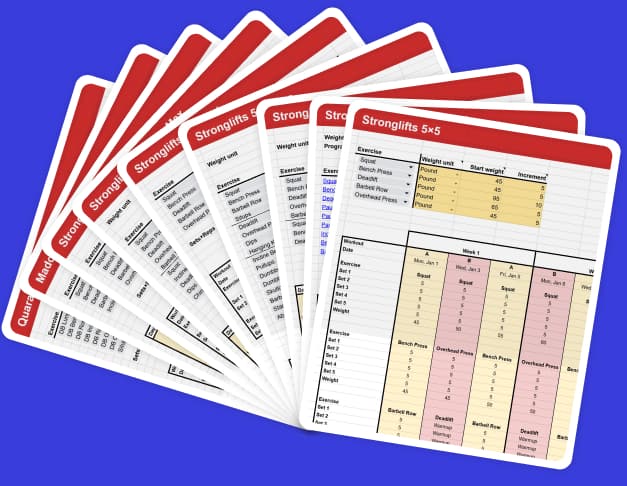Stronglifts 5×5 Plus is an upper-body hypertrophy program that also increases strength. It’s a variation of Stronglifts 5×5 that has an extra workout C with lots of high rep exercises to target the muscles of your upper body.
Stronglifts 5×5 Plus is aimed at lifters who want to focus on their chest, back, arms and abs. The program has fewer Squats than Stronglifts 5×5. Almost 80% of the program’s volume is dedicated to your upper body.
In this guide I’ll show you how Stronglifts 5×5 Plus works.
Contents
- What is the Stronglifts 5×5 Plus Program?
- Muscles worked with Stronglifts 5×5 Plus
- Workout Schedule of Stronglifts 5×5
- How Many Sets & Reps on Stronglifts 5×5 Plus
- Stronglifts 5×5 Plus vs Stronglifts 5×5
- How Stronglifts 5×5 Plus Came to Be
- Stronglifts 5×5 Plus FAQs
- Why is this for hypertrophy?
- How much more muscle will I gain?
- Does exercise variety build more muscle?
- Does this build strength too?
- Who should do Stronglifts 5×5 Plus?
- Who shouldn’t do Stronglifts 5×5 Plus?
- Can you add assistance work?
- Why not do Stronglifts 5×5 with Assistance Work?
- Why less exercises in workouts A/B?
- Isn’t 8 exercises in workout C too many?
- Isn’t 5×5 Deadlifts too much?
- Can I do A/C/B instead of A/B/C?
- Why is this for hypertrophy if the rest time is three minutes?
- Is there a spreadsheet for Stronglifts 5×5 Plus?
- References
Join the Stronglifts community to get free access to all the spreadsheets for every Stronglifts program. You’ll also get daily email tips to stay motivated. Enter your email below to sign up today for free.
What is the Stronglifts 5×5 Plus Program?
The Stronglifts 5×5 Plus program is similar to Stronglifts 5×5. The biggest difference is that there’s a third workout C in which you do almost only upper-body exercises. Here’s the default template…
| Stronglifts 5×5 Plus | ||
|---|---|---|
| Workout A | Workout B | Workout C |
| Squat 5×5 | Deadlift 5×5 | Incline Bench 3×8 |
| Bench Press 5×5 | Overhead Press 5×5 | Pullups 3×8 |
| Barbell Rows 5×5 | Dips 5×5 | Dumbbell Bench 3×8 |
| Situps 3×8 | Planks 3x30sec | Dumbbell Row 3×8 |
| Skullcrushers 3×8 | ||
| Barbell Curl 3×8 | ||
| Calves 3×8 | ||
| Pallof Press 3×8 | ||
You can log Stronglifts 5×5 Plus using the Stronglifts app. Just tap the program tab at the bottom, and then select Stronglifts 5×5 Plus. You’ll find videos and instructions for every exercise.
Muscles worked with Stronglifts 5×5 Plus
Workouts A and B of Stronglifts 5×5 Plus are full body. In these workouts you do exercises for your upper and lower body. Workout C is mostly an upper body workout. In this workout you only do one exercise for your lower body (calves). The other seven exercises are for your upper body.
Stronglifts 5×5 Plus has a lot of exercise variety. You do 16 different exercises each week. About 80% of these, 13 to be exact, target your upper body.
| Stronglifts 5×5 Plus Upper Body Exercises | ||
|---|---|---|
| Workout A | Workout B | Workout C |
| Legs | Legs | Chest/Shoulders/Triceps |
| Chest/Shoulders/Triceps | Shoulders/Triceps | Back/Biceps |
| Back/Biceps | Chest/Triceps | Chest/Shoulders/Triceps |
| Abs | Abs | Back/Biceps |
| Triceps | ||
| Biceps | ||
| Legs | ||
| Abs | ||
Yet Stronglifts 5×5 Plus doesn’t neglect your legs. You’ll still do five sets of Squats, five sets of Deadlifts, and three sets for calves each week. But the program focuses on your upper body more than Stronglifts 5×5.
Workout Schedule of Stronglifts 5×5
With Stronglifts 5×5 Plus you do three workouts a week.
The most popular schedule is Monday, Wednesday and Friday. This gives your muscles one day to recover between workouts (they grow when you rest, not when you train). Here’s how this workout schedule looks…
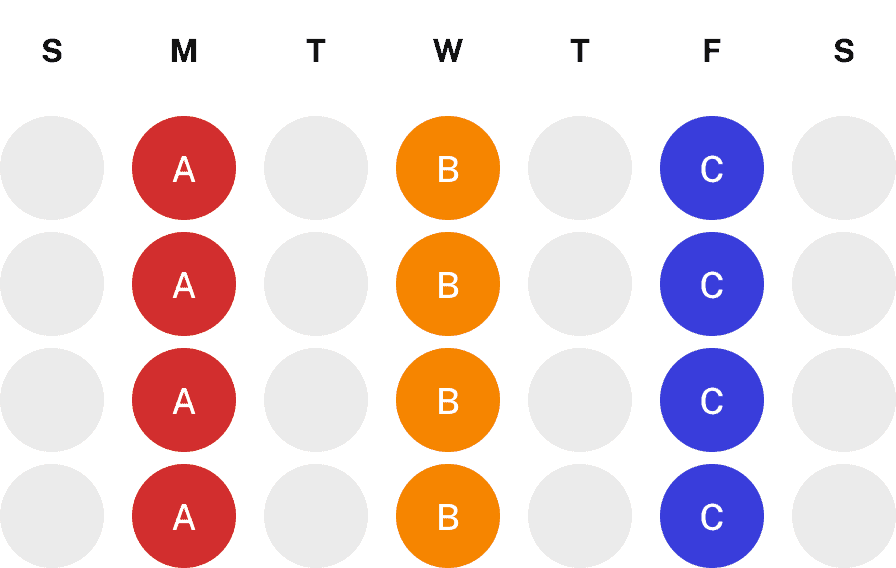
You can train on different days if you prefer. This could be Sun, Tue, Thu, or Tue, Thu, Sat, or Sun, Wed, Fri, or whatever fits you better.
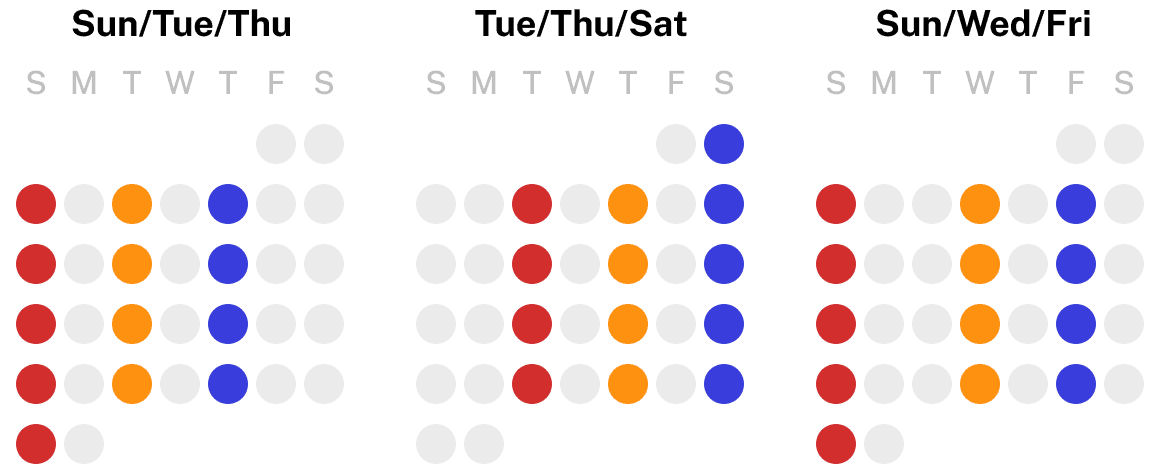
It’s also possible to do two or even three workouts in a row with Stronglifts 5×5 Plus. That’s because unlike Stronglifts 5×5, you’re only Squatting in workout A. You don’t have to do the same Squat again in workout B with more weight. This makes it easier to train back to back if needed. Examples…
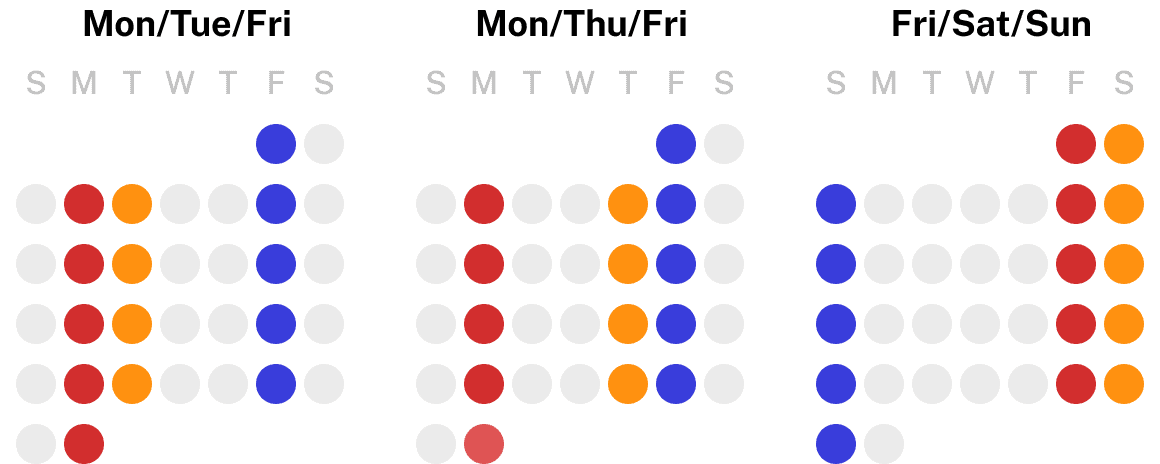
Training three days in a row is not easy. But I often do this when I have to travel for part of the week. Instead of training during the trip or skipping some workouts, I just do them all before I leave. This often goes much better than you’d expect. And your body has four days to recover after that.
The Stronglifts app schedules all your Stronglifts 5×5 Plus workouts for you. It automatically alternates workouts A, B and C each time you go to the gym. All you have to do is follow the app while you focus on lifting.
How Many Sets & Reps on Stronglifts 5×5 Plus
In workout A and B of Stronglifts 5×5 Plus you do 5×5 – five sets of five reps. In the upper-body focused workout C you do 3×8 – three sets of eight reps.
5×5 means five sets of five reps with the same weight after you do your warmup sets for that exercise. Like this…
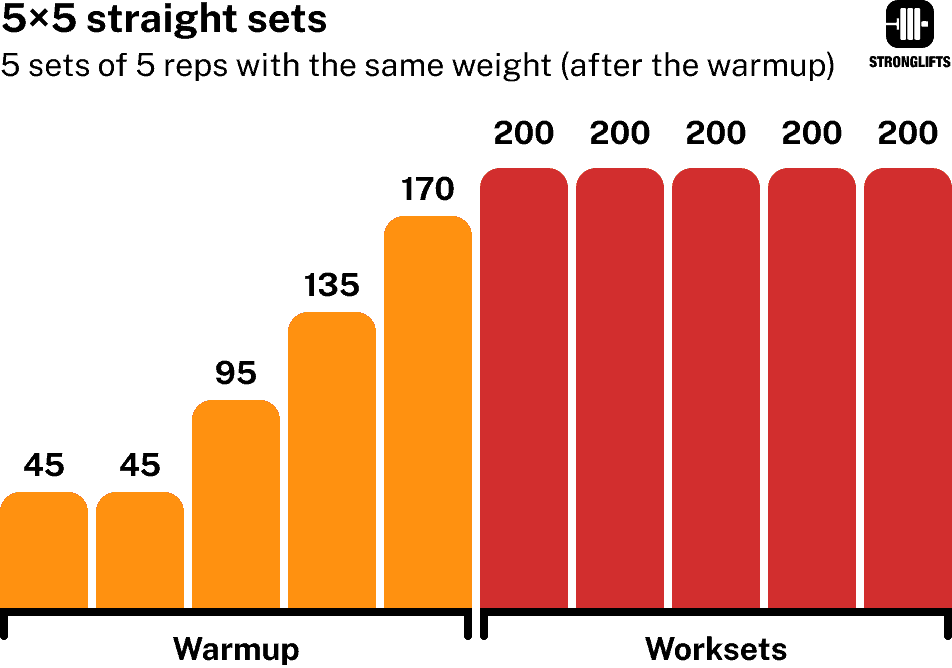
3×8 means three sets of eight reps with the same weight after you do your warmup sets. Like this…
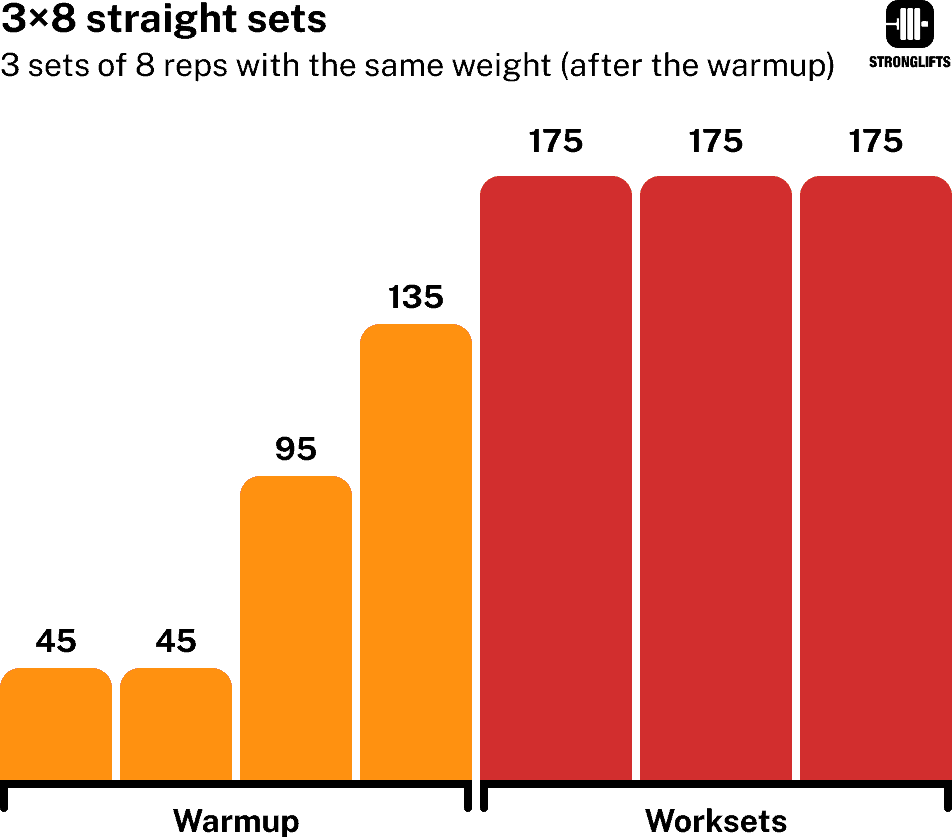
You can switch to top/back-off sets once it becomes harder to add weight with straight sets. You’ll know it’s time to switch when you start failing reps on set two and three. This is when you can start doing one heavy set followed by back-off sets with about 10% less weight. Like this…
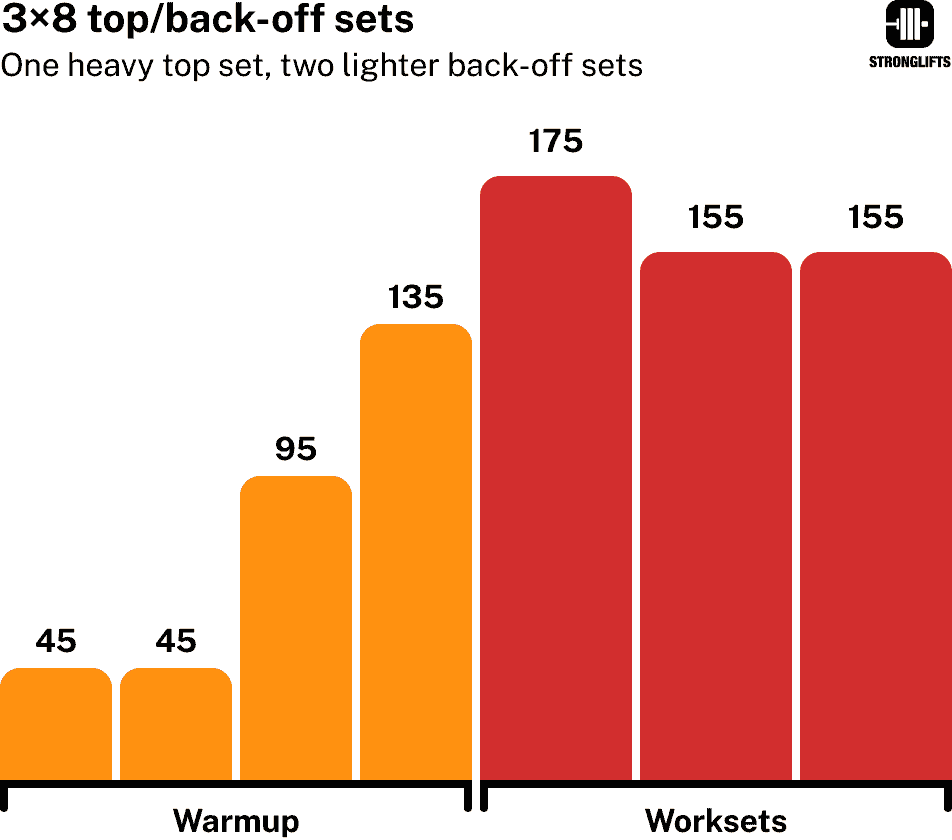
For more information, please read the guide on top/back-off sets.
Stronglifts 5×5 Plus vs Stronglifts 5×5
Stronglifts 5×5 Plus has more volume for your upper body than Stronglifts 5×5. Your training volume is the total work you do per muscle per week. Doing more volume typically results in more muscle growth or hypertrophy (1, 2).
You can easily calculate your training volume by taking the sum of the sets you do for each muscle. For example, if you do five sets of Bench and five sets of Overhead Press, that’s ten sets per week for your shoulders.
Here’s the weekly volume for your major muscle groups on Stronglifts 5×5 compared to Stronglifts 5×5 Plus. Note that we’re taking the average weekly sets of Stronglifts 5×5 because it alternates weeks of workouts A/B/A with B/A/B (you Bench one week 10 sets, one 5 sets, or 7.5 on average).
| Weekly sets | Stronglifts 5×5 | Stronglifts 5×5 Plus |
|---|---|---|
| Chest | 7.5 | 16 (+113%) |
| Back | 9 | 16 (+78%) |
| Shoulders | 15 | 21 (+40%) |
| Triceps | 15 | 24 (+60%) |
| Biceps | 7.5 | 19 (+153%) |
| Legs | 16.5 | 13 (-21%) |
Stronglifts 5×5 Plus has between 40 and 153% more volume for your upper-body muscles compared to Stronglifts 5×5. Here are the exercises that work your major muscle groups on Stronglifts 5×5 Plus…
| Muscle | Sets/week | Exercise |
|---|---|---|
| Chest | 16 | Bench Press, Incline Bench, Dips, Dumbbell Bench |
| Back | 16 | Barbell Row, Pullups, DB Row, Deadlift |
| Shoulders | 21 | Overhead Press, Bench Press, Incline Bench, Dips, Dumbbell Bench |
| Triceps | 24 | Overhead Press, Bench Press, Incline Bench, Dips, Dumbbell Bench, Skullcrushers |
| Biceps | 19 | Barbell Row, Pullups, DB Row, Barbell Curl |
| Legs | 13 | Squat, Deadlift, Calves |
For maximizing hypertrophy or building muscle, it’s recommended to do 10 to 20 sets per week for each muscle group (1, 2, 3, 4, 5). For example, a study by Schoenfeld et al analyzed how many weekly sets you need to do per muscle group to build muscle (1). Here’s what they found…
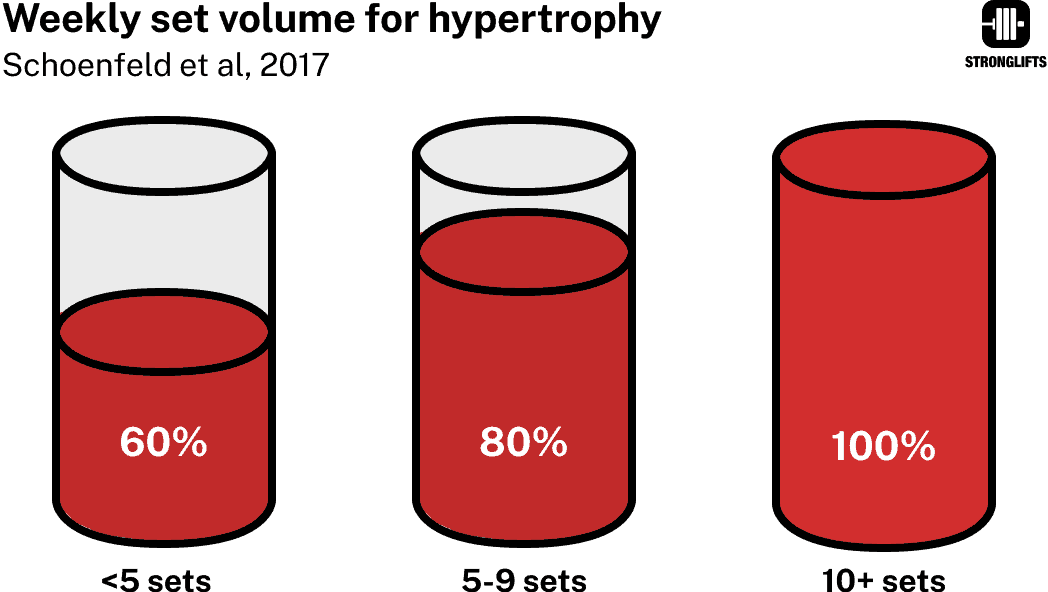
Doing less than five sets per week per muscle group gives you 60% of the hypertrophy gains that you could make. Five to nine sets per week results in about 80% of the muscle gains. Ten or more weekly sets results in 100% of the potential muscle gains. Most of your gains come from the first sets. Each additional set results in extra but smaller gains (diminishing returns).
Ten sets per week is considered high volume (1). This means that Stronglifts 5×5 Plus is a high volume program for all your major muscle groups.
| Muscle | Exercise | Sets/week | Volume |
|---|---|---|---|
| Chest | Bench Press, Incline Bench, Dips, Dumbbell Bench | 16 | High |
| Back | Barbell Row, Pullups, DB Row, Deadlift | 16 | High |
| Shoulders | Overhead Press, Bench Press, Incline Bench, Dips, Dumbbell Bench | 21 | High |
| Triceps | Overhead Press, Bench Press, Incline Bench, Dips, Dumbbell Bench, Skullcrushers | 24 | High |
| Biceps | Barbell Row, Pullups, DB Row, Barbell Curl | 19 | High |
| Legs | Squat, Deadlift, Calves | 13 | High |
However Stronglifts 5×5 Plus is much lower in volume for your legs compared to Stronglifts 5×5. You’re not doing Squats 3x/week but only 1x/week. You’re also not Deadlifting every other workout but only 1x/week. The result is 39% less volume per week for your legs coming from Squats and Deadlifts.
| Leg volume | Stronglifts 5×5 | Stronglifts 5×5 Plus |
|---|---|---|
| Squat | 3x/week | 1x/week |
| Deadlift | 1.5x/week | 1x/week |
| Sets | 16.5/week | 10/week |
| Difference | -39% |
This means that Stronglifts 5×5 Plus dedicates almost 80% of the program’s volume to the upper body. This is higher than Stronglifts 5×5, and that’s why the Plus variation is an upper-body focused hypertrophy program.
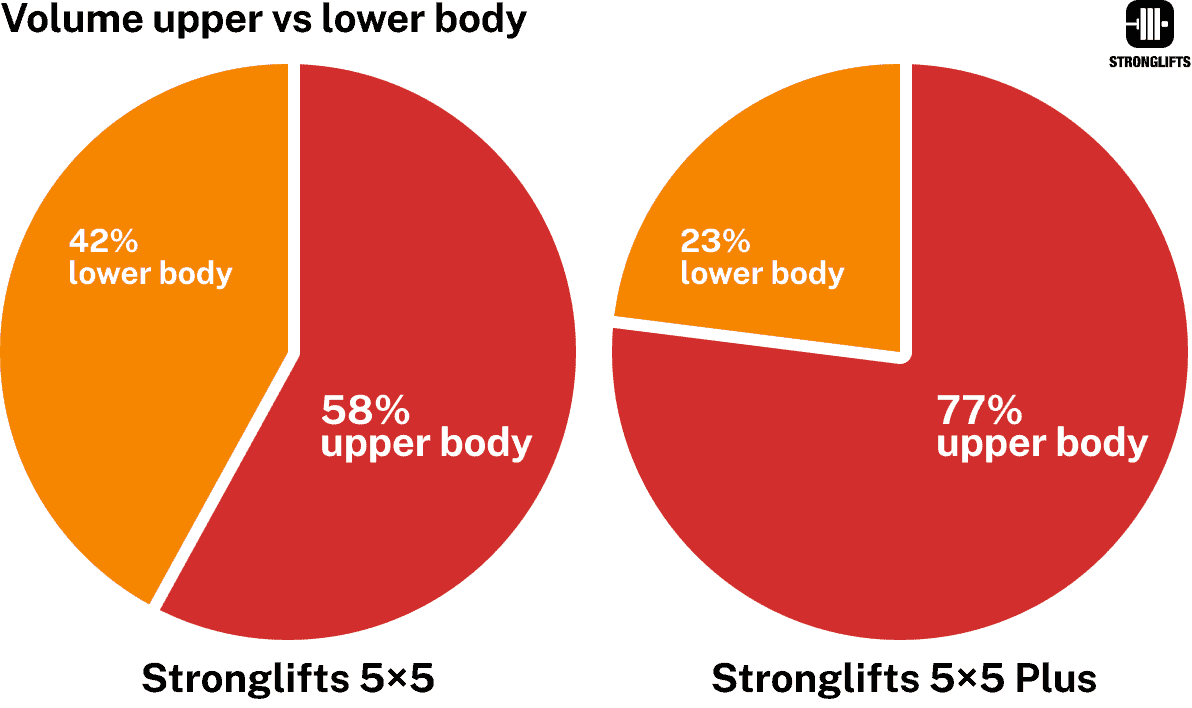
I’m not a fan of doing almost 80% of work for the upper body. Half your muscle mass is in your lower body (6). It therefore makes sense to give an equal amount of attention to your legs as your upper body. This prevents imbalanced physiques like “Chicken legs syndrome”.
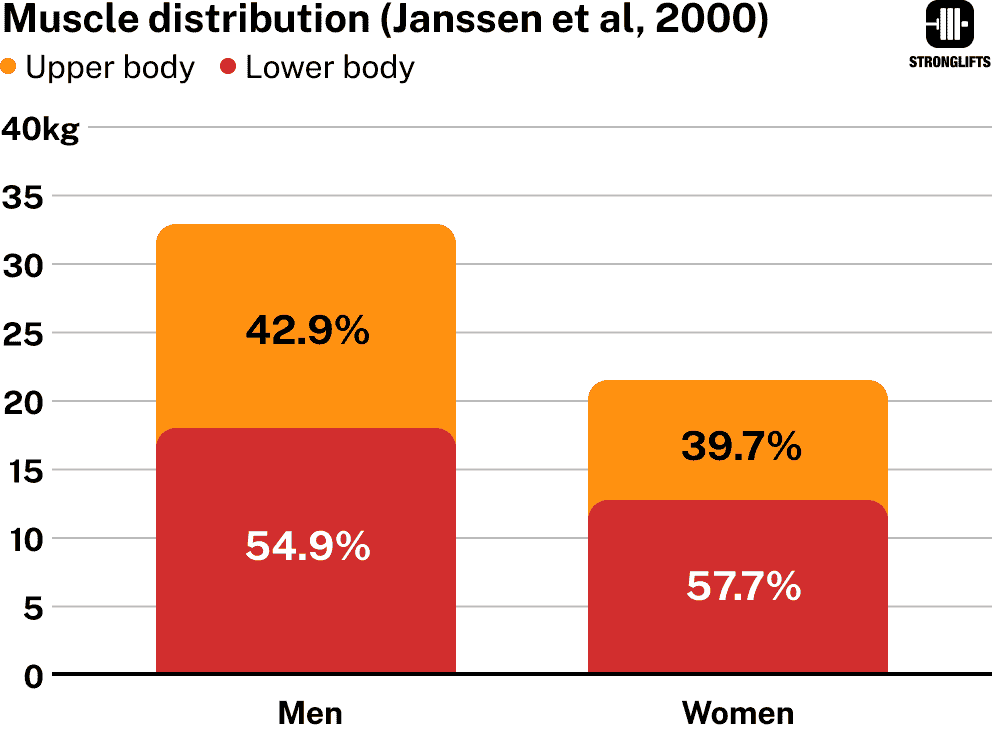
But there are valid situations where it makes sense to focus more on your upper body than the legs. We’ll go over these in the FAQ section below when we’ll discuss who the Stronglifts 5×5 Plus program is for.
You can log Stronglifts 5×5 Plus using the Stronglifts app. Just tap the program tab at the bottom, and then select Stronglifts 5×5 Plus.
How Stronglifts 5×5 Plus Came to Be
As always, the idea for Stronglifts 5×5 Plus came from Stronglifters.
Each day Stronglifters email me their questions, challenges and concerns. I’ve received more than 100,000 emails over the past years. There were two common misconceptions that I saw with Stronglifts 5×5…
One, many people think Stronglifts 5×5 doesn’t build muscle. They look at the program and only see three compound exercises. They don’t see any curls. Don’t see high reps. And so they think that their arms are going to stay small. They think that this program will only build strength, even though the father of the 5×5 workout was a bodybuilder (7). Here’s Reg Park…
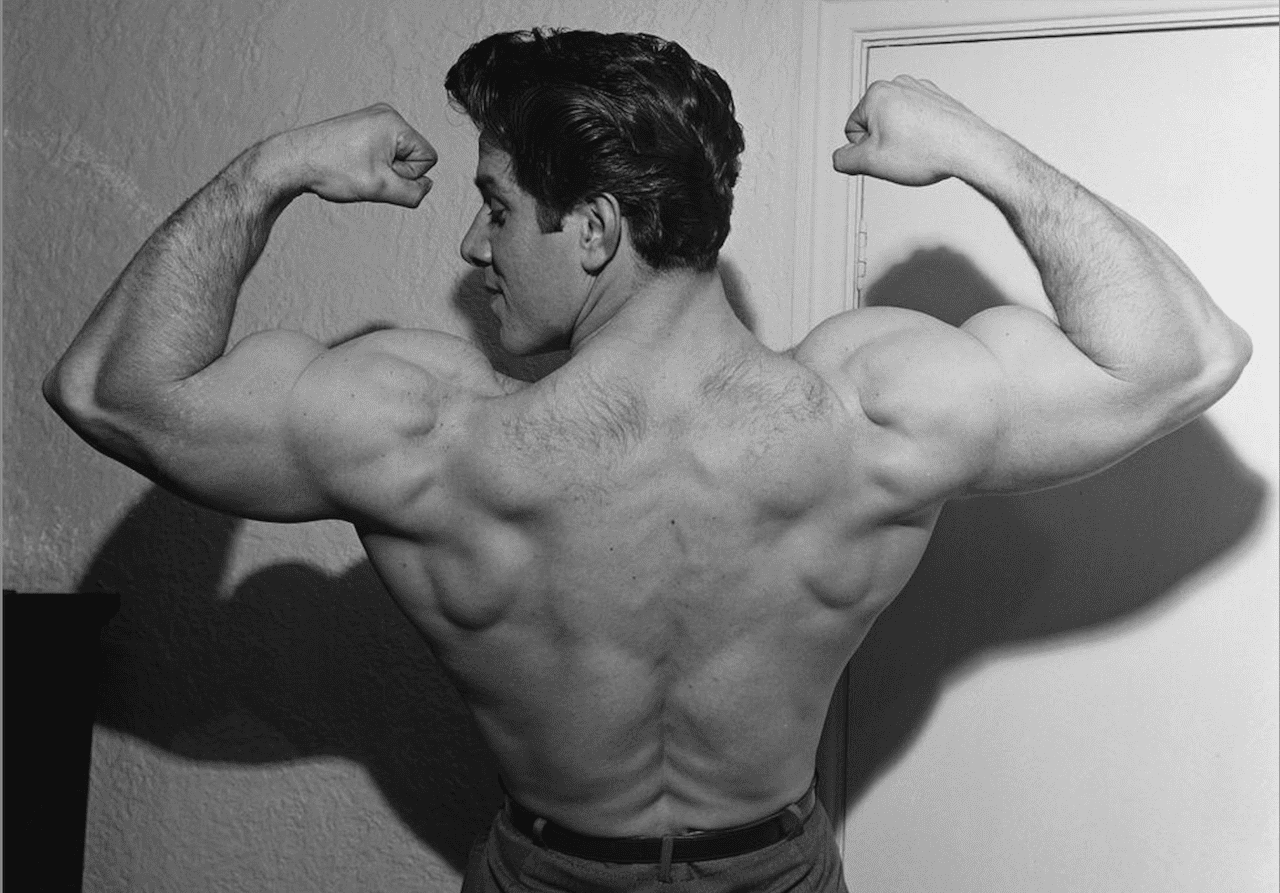
I understand the confusion. I thought the exact same things when I found the 5×5 workout in 2003. I was so skeptical, it took me a year to try the program. They had to kick me out of the gym first. It was only when I was stuck with a home gym and minimal equipment that I gave the program a chance.
That leap of faith helped me to see the truth. None of the things I was afraid of ever happened. Bodybuilding had lied to me. I didn’t have to do all the things they said I had to do in the gym. For example…
- Isolation is not necessary to grow bigger arms. Several studies have compared doing compounds only vs compounds plus isolation (8, 9, 10, 11). The arms always grow bigger when doing only compounds. It’s a myth that they’ll stay small if you don’t add isolation exercises.
- High reps don’t build more muscle than low reps. Several studies have compared lower to higher reps (12, 13, 14, 15). It all builds the same amount of muscle as long as you do enough volume. It’s a myth that eight, ten or twelve reps build more muscle than five reps.
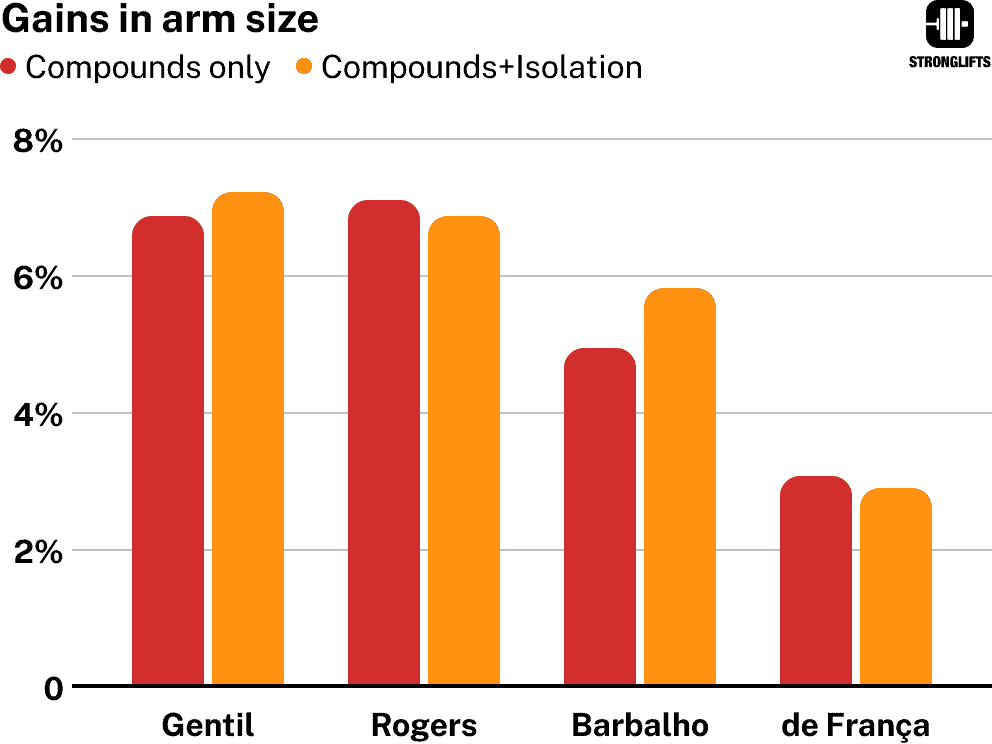
I’ve spent years debunking these myths. Still do. Eventually I concluded that changing people’s beliefs, even with strong evidence, is really hard. It’s better to create a version of Stronglifts 5×5 that looks more like what people expect for building muscle. This program would have exercises targeting every muscle, direct arm work, and the high reps believed to be necessary.
This would also solve the second problem. Many people think that Stronglifts 5×5 has too much volume for the legs. Yet anyone who counts the weekly sets can see that the program has more upper than lower body volume…
| Stronglifts 5×5 | Exercises | Weekly sets | Ratio |
|---|---|---|---|
| Upper body | Bench, OHP, Row | 22.5 | 58% |
| Lower body | Squat, Deadlift | 16.5 | 42% |
People who think Stronglifts 5×5 is too much legs seem to fixate on the Squats in every workout. I understand this. I also thought Squatting 3x/week was too much when I found the 5×5 workout 22 years ago. I didn’t understand that you weren’t supposed to train to failure or do this forever.
Bodybuilding has taught many people to train legs only once a week. Yet it’s normal for powerlifters to Squat 2x/week and Deadlift 1.5x/week (16). Many bodybuilders use push pull legs, upper-lower or full body splits where they train legs 2-3x/week. Lots of gym goers hate training legs because they only do it once a week. This forces them to cram all the volume into one grueling workout. It’s much easier to spread the leg volume over several days.
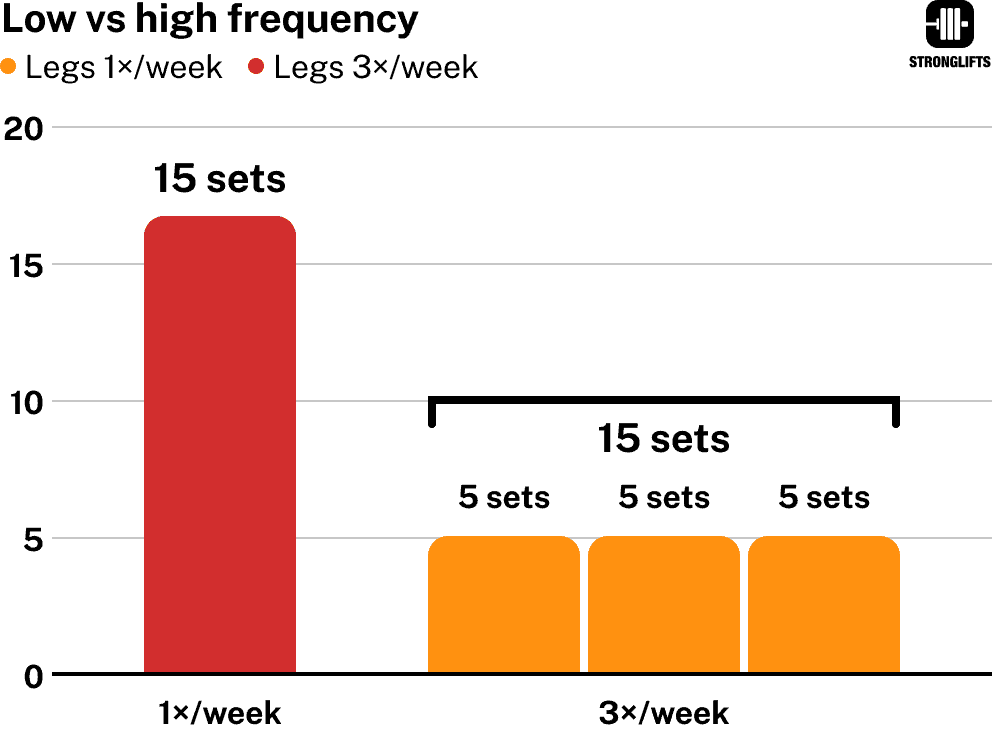
But again, it’s hard to change people’s beliefs, even with strong evidence. So I decided to create a variation of Stronglifts 5×5 that keeps the fundamental principles of compound exercises and progressive overload. But it would have one exercise targeting every muscle, including the biceps, calves and abs. It would also have high reps for more “pump”. And it would have fewer Squats. The workouts would look more like what people expect for hypertrophy.
This program turned out to have almost 80% volume for the upper body. So I called it Stronglifts 5×5 Plus – an upper-body hypertrophy program. You can log it with the Stronglifts app (tap program – select Stronglifts 5×5 Plus).
Stronglifts 5×5 Plus FAQs
Why is this for hypertrophy?
For building muscle, your training program needs two critical things…
- Progressive overload: adding weight on the bar over time is the main driver of muscle growth (17, 18, 19). If you don’t lift more weight than six months ago, you won’t look any different. Most gym goers struggle to build muscle because they lift weights that are too light (20, 21). Adding weight on the bar systematically ensures that you’re training heavy enough to stimulate muscle growth. Strength is size.
- Volume: your training volume is how many weekly sets you do for each muscle. Doing just one set per week doesn’t maximize hypertrophy (1). 10 to 20 weekly sets per muscle is recommended (2, 3, 4, 5). Note that for compound exercises, one set of say Bench Press equals one set for chest, one for shoulders and one for triceps (22).
Stronglifts 5×5 Plus is a hypertrophy program because it focuses on the fundamental training principle of muscle building: progressive overload. In fact, the Stronglifts app automates this whole process for you. It automatically increases the weight when you complete all your sets. You can control how much weight it adds, and how often it does that.
Stronglifts 5×5 also focuses on progressive overload (that’s why it builds muscle too). The difference is that Stronglifts 5×5 Plus is higher in volume for the upper body. It has more exercises for your chest, back and arms. Doing more volume typically results in more muscle growth or hypertrophy (1, 2).
| Weekly sets | Stronglifts 5×5 | Stronglifts 5×5 Plus |
|---|---|---|
| Chest | 7.5 | 16 (+113%) |
| Back | 9 | 16 (+78%) |
| Shoulders | 15 | 21 (+40%) |
| Triceps | 15 | 24 (+60%) |
| Biceps | 7.5 | 19 (+153%) |
| Legs | 16.5 | 13 (-21%) |
Stronglifts 5×5 Plus is a hypertrophy program because it focuses on the fundamental muscle building principles of training with progressive overload and sufficient volume. It’s an upper-body hypertrophy program because 80% of the volume is dedicated to your upper body.
How much more muscle will I gain?
The study by Schoenfeld et al showed that doing ten or more weekly sets for a muscle results in 20% more gains than five to nine weekly sets (1). Every additional set you do results in extra but smaller gains.

This means that you shouldn’t expect to build twice the amount of muscle compared to Stronglifts 5×5. You also shouldn’t expect to build muscle twice as fast. Building muscle is a slow process because it requires adding tissue. It’s like growing longer hair. It takes time, even if you do more volume.
You’ll build a little bit more muscle in the upper-body with Stronglifts 5×5 Plus. You’ll also feel more pump from the higher reps in workout C. But the overall effect will be small since most of the gains come from workouts A and B.
Does exercise variety build more muscle?
It doesn’t seem so.
Stronglifts 5×5 Plus has more exercise variety than Stronglifts 5×5. For example, instead of only doing the Bench Press for your chest, you’re also doing the Incline Bench Press, Dumbbell Bench Press and Dips. A study by Kassiano et al found that doing different exercises can help specific parts of your muscles grow more (23). Take the Incline Bench Press. It works your upper-chest a little more than the flat Bench Press (24).
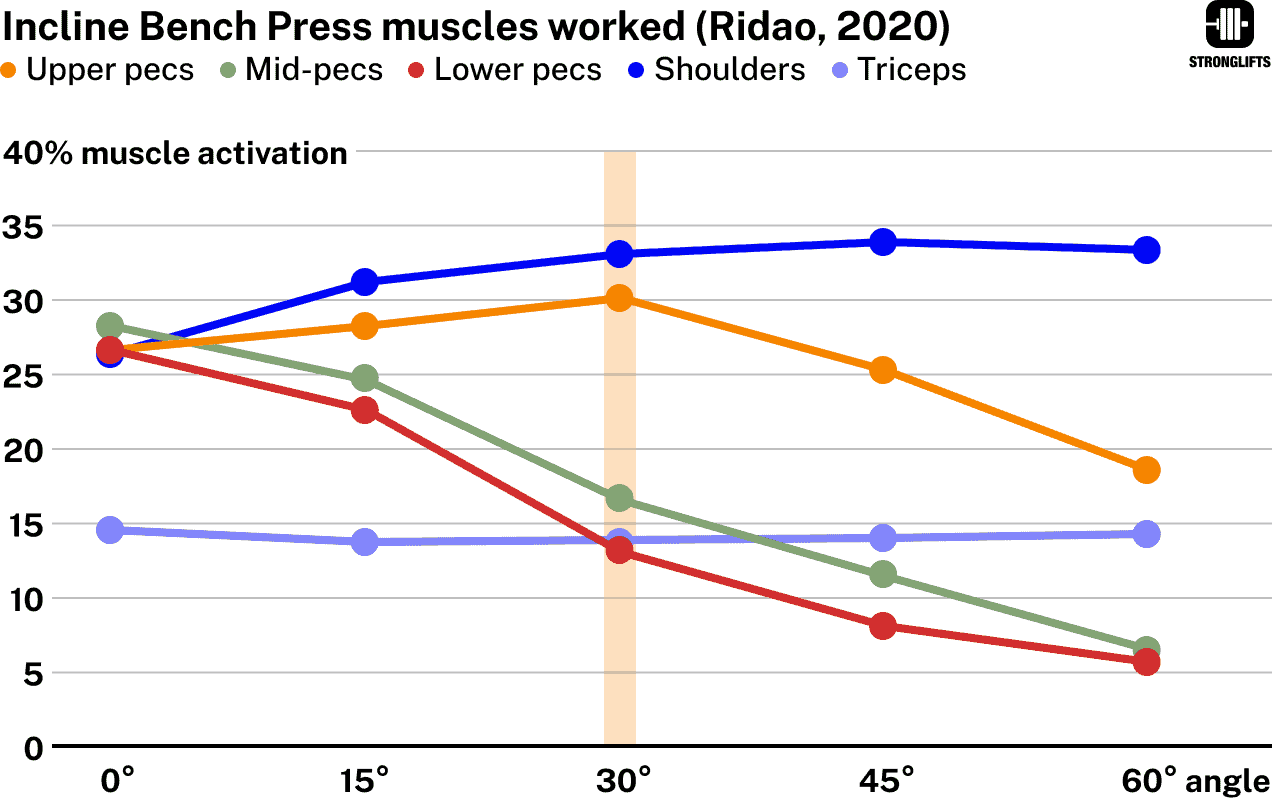
But exercise variety doesn’t seem to affect the overall size of your muscle (23). While some parts may grow a little more, you may not have more muscle than before. What matters most for building muscle is adding weight on the bar over time and doing enough volume (1, 2, 3, 4, 5, 17, 18, 19).
A common beginner’s mistake is to get distracted by details and lose sight of the big picture. Pareto’s principle, also known as the 80/20 rule, states that 80% of your results will come from 20% of your actions.
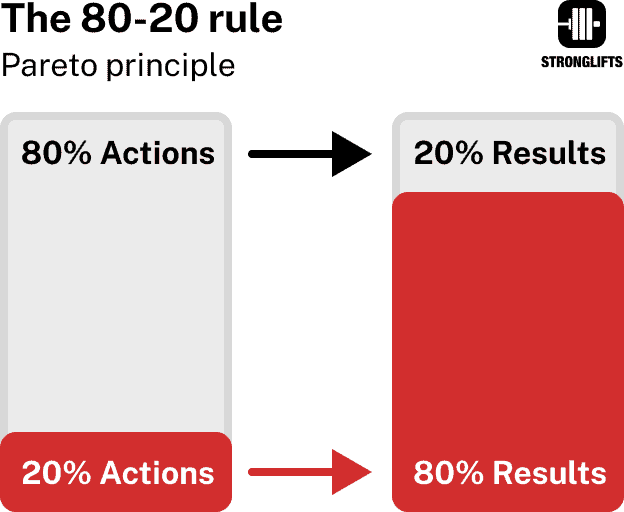
For hypertrophy, applying progressive overload and doing enough volume will drive the large majority of your muscle gains. They’re the two most important training principles you need to focus on in the gym. Everything else can make a small difference. But they don’t replace the fundamental principles of adding weight and doing enough volume. Failure to do so will hinder your muscle growth because your program doesn’t have the fundamentals in place.
Does this build strength too?
Yes, but not as much as Stronglifts 5×5 for your Squat and Deadlift.
Strength = skills × muscle (25, 26, 27, 28). Think of it like car racing. You need a car with a big motor (big muscles). But you also need a skilled driver (good technique). One without the other is playing half the field.
Squats are the most technical exercise. The bar moves a greater distance than on the other lifts. You’re using more muscles and lifting heavier weights. You have to lower the bar all the way down then come back up. A lot of things can go wrong. If you Squat only once a week, like you do on Stronglifts 5×5 Plus, then you get less practice than if you do it 3x/week. Compare…
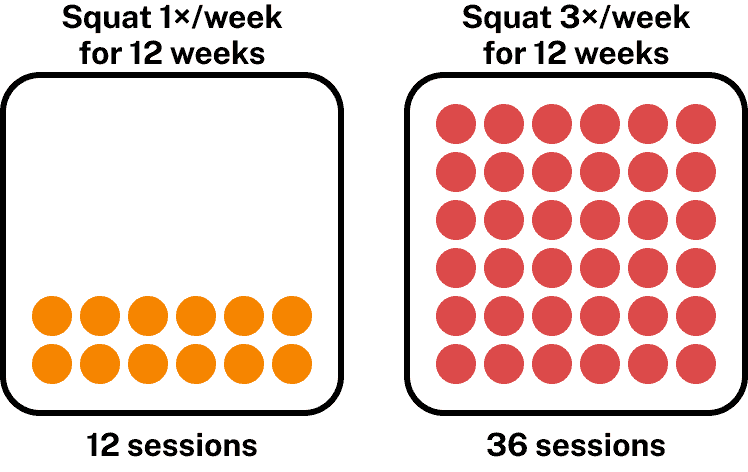
On Stronglifts 5×5 Plus you’re only Squatting 1x/week. It will therefore take you longer to acquire basic skills compared to Stronglifts 5×5 where you do it 3x/week. It will take you longer to get comfortable doing Squats.
On top of this, you’re only doing 5 sets of Squats each week on Stronglifts 5×5 Plus. A study by Ralston et al analyzed how many sets you need per week per exercise to get stronger (29). Here’s what they found…
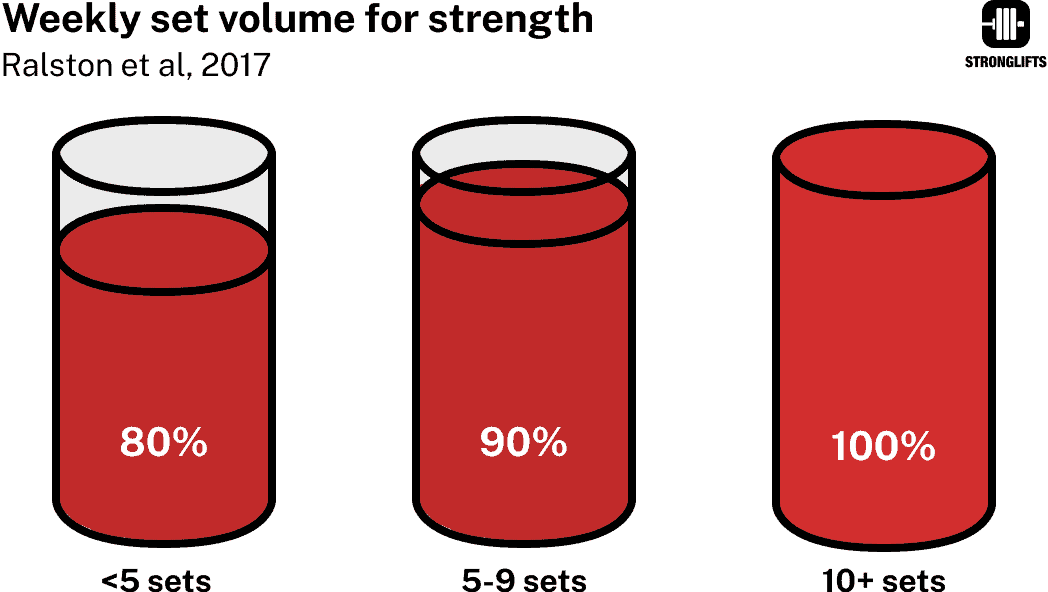
Doing ten or more weekly sets of Squats results in 100% strength gains. Five to nine sets per week is 90% of strength gains. Less than 5 sets per week is 80% of strength gains. Stronglifts 5×5 has 15 weekly Squat sets. The Squat volume and frequency is 3x higher than on Stronglifts 5×5 Plus.
| Squat volume | Stronglifts 5×5 | Stronglifts 5×5 Plus |
|---|---|---|
| Weekly sets | 15 | 5 |
| Frequency | 3×/week | 1×/week |
Your Squat will increase faster and more with Stronglifts 5×5. This doesn’t mean that it can’t get stronger with Stronglifts 5×5 Plus. But it shows that there is no perfect program. Adding the extra workout C to focus more on the upper-body reduced the Squat volume. This impacts progress on that lift.
Who should do Stronglifts 5×5 Plus?
Stronglifts 5×5 Plus will be a great program for you if…
- You’ve been doing Stronglifts 5×5 for a while. You’re bored of doing the same exercises. Stronglifts 5×5 Plus has 16 different exercises and a new workout C. The exercise variety will challenge your body in new ways. Your workouts will be interesting again.
- You’re dreading Squatting 3x/week. It has become too hard now that you’re lifting heavier weights. Developing your legs isn’t your priority. Stronglifts 5×5 Plus only has one Squat session a week. This is easier to manage now that you’re much stronger.
- Your legs are big enough. You prefer to focus more on your chest, back, shoulders, arms and abs. Stronglifts 5×5 Plus has almost 80% volume for your upper body.
You can log Stronglifts 5×5 Plus using the Stronglifts app. Just tap the program tab at the bottom, and then select Stronglifts 5×5 Plus.
Who shouldn’t do Stronglifts 5×5 Plus?
Stronglifts 5×5 Plus is not a program for new or returning lifters.
It’s not a program for lifters who are not familiar with the proper form of basic compound exercises like the Squat, Bench and Deadlift. Here’s a comment from a Stronglifter about Stronglifts 5×5 that illustrates why…
I tried to workout many times in the past but it’s my first time feel I actually enjoy it, as I progress fast. The fact that there’s only 5 exercises make me to focus on forms and techniques, instead of learning tens of exercises but good at none. The app is very good. Simple and smooth. Well done!
-Moni
On Stronglifts 5×5 you only do five different exercises. You lift 3x/week and alternate two workouts A and B. One workout you Squat, Bench Press and Barbell Row. The other you Squat, Overhead Press and Deadlift. And so you practice these basic exercises more often than on Stronglifts 5×5 Plus.
| Frequency | Stronglifts 5×5 | Stronglifts 5×5 Plus |
|---|---|---|
| Squat | 3×/week | 1×/week |
| Bench | 1.5×/week | 1×/week |
| Deadlift | 1.5×/week | 1×/week |
| OHPress | 1.5×/week | 1×/week |
| Barbell Row | 1.5×/week | 1×/week |
The priority for new or returning lifters is to learn proper form. You can’t go heavy on big compound lifts like Squats before you have the basic form down. The more you practice the exercise, the quicker you learn the form, and the faster you can start going heavy to stimulate your muscles to grow.
That’s why I recommend doing Stronglifts 5×5 for at least eight weeks before doing Stronglifts 5×5 Plus. This will help you practice and master the basics. It will help you get better results with Stronglifts 5×5 Plus later. If you’re a new or returning lifter, you shouldn’t start with Stronglifts 5×5 Plus.
Can you add assistance work?
You could, but why? You’re already doing enough volume. More is better but only up to a point. Doing too much volume can backfire.
For building muscle, the recommendations are to do 10 to 20 sets per week for each muscle group (1, 2, 3, 4, 5). Compare that to the weekly volume for your major muscle groups on Stronglifts 5×5 Plus…
| Muscle | Sets/week | Exercise |
|---|---|---|
| Chest | 16 | Bench Press, Incline Bench, Dips, Dumbbell Bench |
| Back | 16 | Barbell Row, Pullups, DB Row, Deadlift |
| Shoulders | 21 | Overhead Press, Bench Press, Incline Bench, Dips, Dumbbell Bench |
| Triceps | 24 | Overhead Press, Bench Press, Incline Bench, Dips, Dumbbell Bench, Skullcrushers |
| Biceps | 19 | Barbell Row, Pullups, DB Row, Barbell Curl |
| Legs | 13 | Squat, Deadlift, Calves |
You’re already doing more than 20 sets per week for your shoulders and triceps. You’re doing almost 20 sets for biceps. Chest and back is 16 sets per week each. So what would you add assistance work for? Even your abs get nine sets per week, and that doesn’t include the indirect ab work that you get from heavy Squats, Deadlifts, and Overhead Press.
Doing too much volume can hurt your gains by causing excess fatigue.
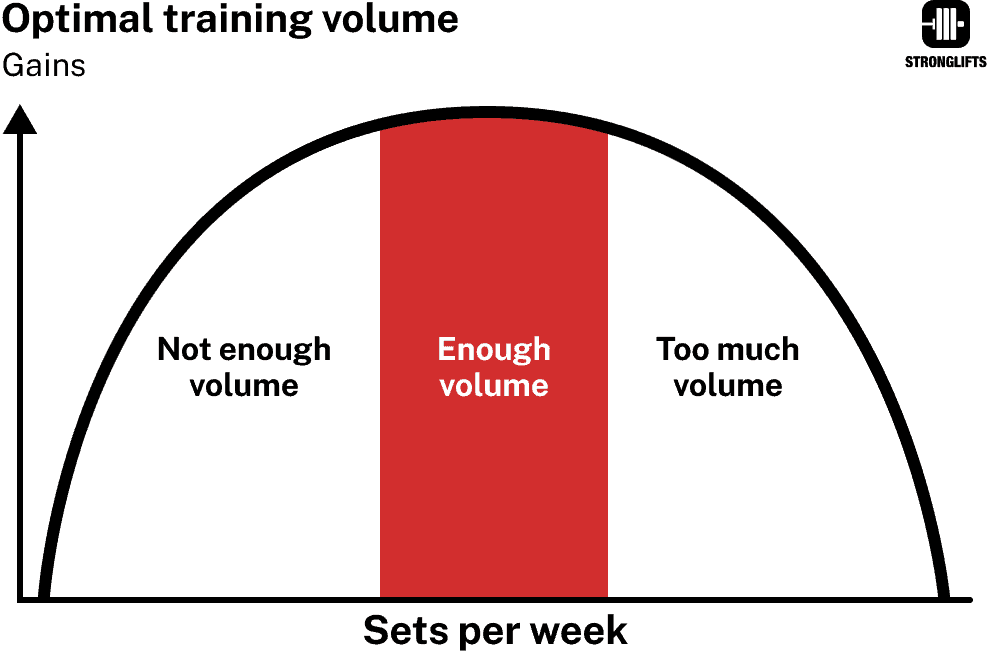
The smart way to train is to do the minimum amount of volume that you need to progress. Only add volume once you get stuck.
Why not do Stronglifts 5×5 with Assistance Work?
Instead of Stronglifts 5×5 Plus, you could indeed do Stronglifts 5×5 with extra Assistance Work for Chest/Back. This would also increase the weekly training volume for your upper body to drive more hypertrophy.
Let’s first look at the weekly training volume for your upper body on Stronglifts 5×5 vs Stronglifts 5×5 with Assistance Work for Chest/Back.
| Sets/week | Stronglifts 5×5 | +Assistance Chest/Back |
|---|---|---|
| Chest | 7.5 | 12 (+60%) |
| Back | 9 | 15.5 (+72%) |
| Shoulders | 15 | 19.5 (+30%) |
| Triceps | 15 | 24 (+60%) |
| Biceps | 7.5 | 20 (+167%) |
| Exercises | Bench, Overhead Press, Row | Bench, Overhead Press, Row, Pullup, Dips, Curl, Skullcrushers |
Compare the weekly training volume of Stronglifts 5×5 with Assistance Work for Chest/Back to the volume of Stronglifts 5×5 Plus…
| Sets/week | SL5×5+Assist | SL5×5 Plus | Difference |
|---|---|---|---|
| Chest | 12 | 16 | 4 (+33%) |
| Back | 15.5 | 16 | -0.5 (+3%) |
| Shoulders | 19.5 | 21 | +1.5 (+8%) |
| Triceps | 24 | 24 | 0 |
| Biceps | 20 | 19 | -1 (-5%) |
| Legs | 16.5 | 13 | -3.5 (-27%) |
The training volume is about the same for your back, shoulders, triceps and biceps. The main difference is that Stronglifts 5×5 Plus has 33% more training volume for your chest but 27% less for your legs (even less if you don’t count calves). If you care more about legs, Stronglifts 5×5 + Assistance Work is better. If you care more about chest, Stronglifts 5×5 Plus is better. How much better? Well, not dramatically better. But a little better.
Another factor is gym time. The extra Assistance Work for Stronglifts 5×5 takes an extra 15min. Workouts A and B therefore take longer because you have to do two extra exercises after the three main lifts. Some people struggle to put effort in the assistance work because they’re tired by then.
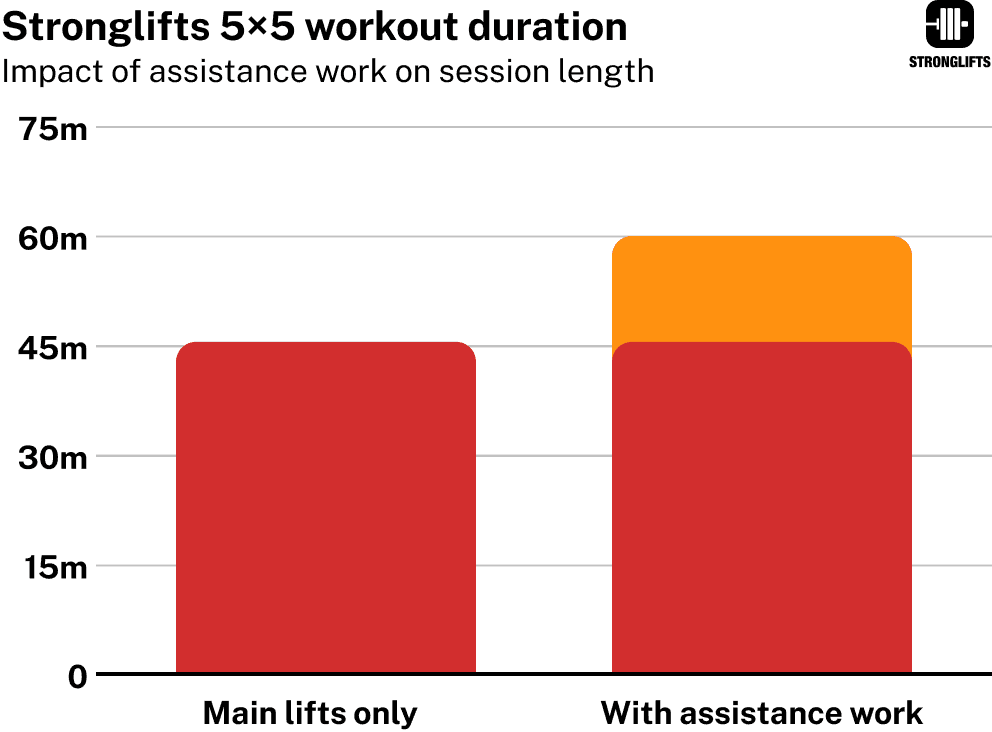
With Stronglifts 5×5 Plus, you’re only doing four exercises in workouts A and B. The fourth exercise is abs which doesn’t take that long. In Workout B you don’t Squat. You do Deadlifts, Overhead Press, Dips and abs. Workout B takes less time than when you do Stronglifts 5×5 with Assistance Work.
Stronglifts 5×5 Plus will feel easier because you only Squat and Deadlift 1x/week, and in separate workouts. The training volume for your legs is lower, but the progression is slower as well. This is easier to sustain past the easy beginner gains. The upper body muscle gains will be similar for both programs. It mostly comes down to what you prefer.
Why less exercises in workouts A/B?
You’re indeed doing half the amount of exercises in workouts A/B compared to C. This may seem imbalanced. But if you count the total sets per workout, you’ll find that you only do 33% fewer sets in workouts A and B.
| Stronglifts 5×5 Plus | ||
|---|---|---|
| Workout A | Workout B | Workout C |
| Squat 5×5 | Deadlift 5×5 | Incline Bench 3×8 |
| Bench Press 5×5 | Overhead Press 5×5 | Pullups 3×8 |
| Barbell Rows 5×5 | Dips 5×5 | Dumbbell Bench 3×8 |
| Situps 3×8 | Planks 3x30sec | Dumbbell Row 3×8 |
| Skullcrushers 3×8 | ||
| Barbell Curl 3×8 | ||
| Calves 3×8 | ||
| Pallof Press 3×8 | ||
| 18 sets | 18 sets | 24 sets (+33%) |
Workouts A and B have fewer exercises because you do more sets – five vs three in workout C. You also Squat and Deadlift in workouts A and B. These exercises work the greatest amount of muscles, and the largest ones. You can lift heavier weights than on upper body lifts that use smaller muscles. The warmup up alone takes longer because your top weight is higher.
Workouts A and B are more demanding. They have fewer exercises to account for the more challenging Squats and Deadlifts that you do for five sets. Don’t make the mistake of adding four exercises to workouts A and B to “make it even”. These two workouts will take you as much time as workout C, even though they have half the number of exercises.
Isn’t 8 exercises in workout C too many?
You need to look at the types of exercises you do in each workout, not just the number of exercises. Here’s a quick table categorizing each lift…
| Stronglifts 5×5 Plus | ||
|---|---|---|
| Workout A | Workout B | Workout C |
| BB Compound Legs | BB Compound Legs | BB Compound Chest |
| BB Compound Chest | BB Compound Shoulder | BB Compound Back |
| BB Compound Back | BW Compound Chest | DB Compound Chest |
| BW Isolation Abs | BW Isolation Abs | DB Compound Back |
| BB Isolation Triceps | ||
| BB Isolation Biceps | ||
| BB Isolation Calves | ||
| BW Isolation Abs | ||
Half the exercises of workout C are isolation. They work one muscle at a time. This limits how heavy you can go, and makes the workout less demanding. You’re not getting out of breath after a set of curls as you do with Squats.
Workouts A and B have three compound exercises, including one for the legs. Workout C has four compound lifts, but none for the legs. Half of them are dumbbell exercises. All of this makes workout C less demanding than A/B – the exercises use less muscles, smaller muscles, and the weight you lift is lighter (especially when using dumbbells).
Isn’t 5×5 Deadlifts too much?
No.
You don’t Squat 3x/week like on Stronglifts 5×5. You also don’t Deadlift on the same day as you Squat. You Deadlift as the first exercise of workout B. This makes five sets possible. Stronglifts 5×5 Intermediate does this as well.
Note that you can use top/back-off sets to reduce fatigue and save time if you’re past the easy beginner gains for your Deadlift.
Can I do A/C/B instead of A/B/C?
You could change the workout order of Stronglifts 5×5 Plus to this…
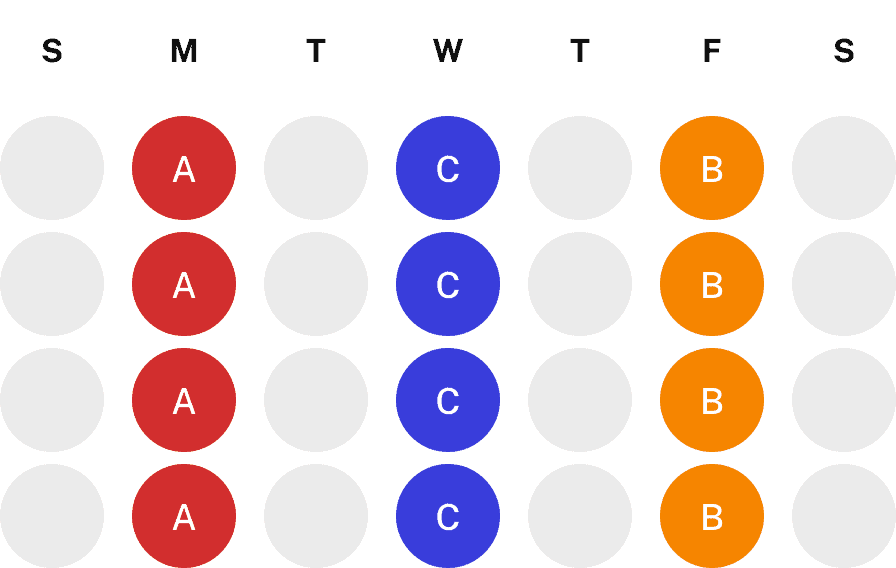
Here are the exercises in each workout for context…
| Stronglifts 5×5 Plus | ||
|---|---|---|
| Workout A | Workout C | Workout B |
| Squat 5×5 | Incline Bench 3×8 | Deadlift 5×5 |
| Bench Press 5×5 | Pullups 3×8 | Overhead Press 5×5 |
| Barbell Rows 5×5 | Dumbbell Bench 3×8 | Dips 5×5 |
| Situps 3×8 | Dumbbell Row 3×8 | Planks 3x30sec |
| Skullcrushers 3×8 | ||
| Barbell Curl 3×8 | ||
| Calves 3×8 | ||
| Pallof Press 3×8 | ||
The benefit of following the A/C/B schedule is that your legs have more rest days after Squats before you Deadlift. Compare…
| Rest days legs | ABC | ACB |
|---|---|---|
| After Squat | 1 | 3 |
| After Deadlift | 4 | 2 |
If you follow the default ABC schedule of Stronglifts 5×5 Plus, your legs only have one rest day after Squats but four after Deadlifts. If you follow the ACB schedule instead, your legs have three rest days after Squat and two after Deadlifts. The ACB schedule spreads out the rest days more.
The ACB schedule seems better. So why didn’t I setup Stronglifts 5×5 Plus like that then? Because many people struggle to lift 3x/week consistently. Thousands of people log their workouts with the Stronglifts app. We have a lot of data. The third workout at the end of the week, no matter the program, is skipped more often than the two workouts earlier in the week.
My bias is to prioritize the Squat, Bench and Deadlift. They’re fundamental exercises and thus more important than all the rest. I put them in workouts A and B so you start your week with them. These are harder workouts and so it makes sense to do them right after the weekend when you have two days off to recover. Plus if you skip workout C, you did the most important lifts.
If you rarely skip workouts, then the A/C/B schedule is fine. You can set this in the Stronglifts app by going to program – workouts – reorder workout C so it’s in the middle. Your schedule will automatically update.
Why is this for hypertrophy if the rest time is three minutes?
Longer rest times help you do more reps and lift heavier weights. This results in more volume, which increases the amount of muscle you gain.
Contrary to popular belief, shorter rest periods don’t build more muscle (31). They give your ATP-PC energy system less time to recover. Research shows that your energy stores are only 75% recovered after 1min rest, but 91% after 3min and 95% after 5min (32). Longer rest periods help you do more reps per set and lift heavier because your energy stores have more time to recover.
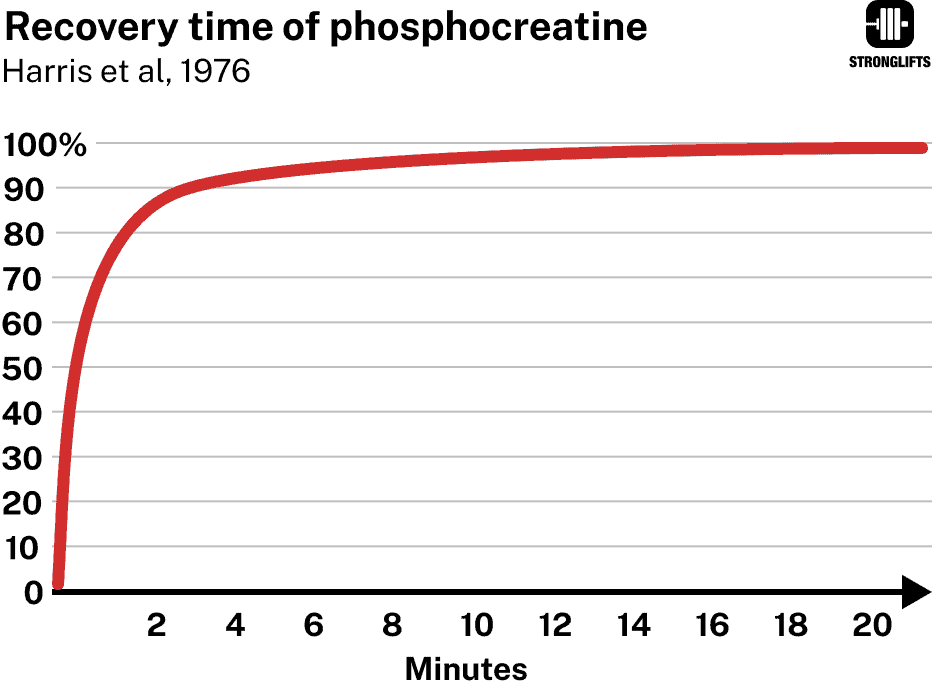
For example, a study by Hernandez et al had 15 men Bench Press four sets with 85% of their max (33). The group that rested 2min did 16 reps in total. The 5min group did 19 reps. The 8min group did 24 reps. They did more reps because their energy stores were more recovered.
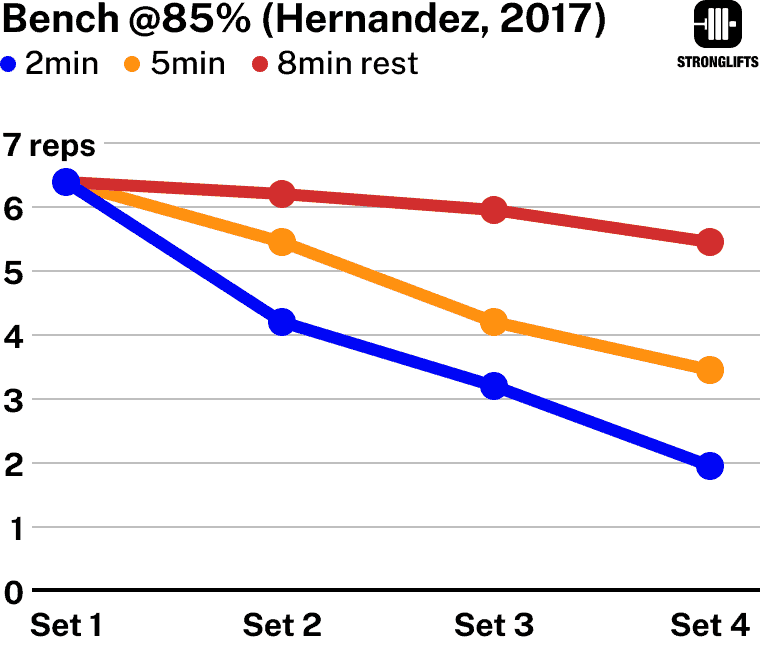
Longer rest periods help you do more volume, which typically results in more muscle gains (1, 2). A study by Longo et al compared one and three minutes rest (31). The 1min group had to do more sets to get the same result as the 3min group. That’s because shorter rest periods result in less volume (fewer reps per set and/or less weight lifted). Unless you do more sets to make up for the lower volume, you’ll build less muscle, not more.
You can set shorter rest periods in the Stronglifts app if you want. Just go to Stronglifts – settings – timer. However, since shorter rest periods don’t build more muscle but usually result in less volume, I recommend resting as much as you need to complete all your reps on each set. The higher volume that you’ll achieve with longer rest periods is what results in more muscle.
Is there a spreadsheet for Stronglifts 5×5 Plus?
Yes, just go to Stronglifts 5×5 Plus spreadsheet.
The spreadsheet is great for getting a big picture overview of how the program works, and how your weights will progress. But for logging your workouts in the gym, use the Stronglifts app. It’s easier to use, does all the math for you, and has lots of extra features like a built-in rest timer.
Join the Stronglifts community to get free access to all the spreadsheets for every Stronglifts program. You’ll also get daily email tips to stay motivated. Enter your email below to sign up today for free.
References
1. Schoenfeld, Brad J et al. “Dose-response relationship between weekly resistance training volume and increases in muscle mass: A systematic review and meta-analysis.” Journal of sports sciences vol. 35,11 (2017): 1073-1082.
2. DE Camargo, Júlio Benvenutti Bueno et al. “Manipulating Resistance Training Variables to Induce Muscle Strength and Hypertrophy: A Brief Narrative Review.” International journal of exercise science vol. 15,4 910-933. 1 Jul. 2022.
3. Schoenfeld, Brad, and Jozo Grgic. “Evidence-Based Guidelines for Resistance Training Volume to Maximize Muscle Hypertrophy.” Strength & Conditioning Journal, vol. 40, no. 4, 2018, pp. 107-112.
4. Baz-Valle, Eneko et al. “A Systematic Review of The Effects of Different Resistance Training Volumes on Muscle Hypertrophy.” Journal of human kinetics vol. 81 199-210. 10 Feb. 2022.
5. Bernárdez-Vázquez, Roberto et al. “Resistance Training Variables for Optimization of Muscle Hypertrophy: An Umbrella Review.” Frontiers in sports and active living vol. 4 949021. 4 Jul. 2022.
6. Janssen, I et al. “Skeletal muscle mass and distribution in 468 men and women aged 18-88 yr.” Journal of applied physiology (Bethesda, Md. : 1985) vol. 89,1 (2000): 81-8.
7. Park, Reg. “Strength & Bulk Training for Weight Lifters & Body Builders”. 1958.
8. de França, Henrique Silvestre et al. “The effects of adding single-joint exercises to a multi-joint exercise resistance training program on upper body muscle strength and size in trained men.” Applied physiology, nutrition, and metabolism = Physiologie appliquee, nutrition et metabolisme vol. 40,8 (2015): 822-6.
9. Barbalho, Matheus et al. “Does the addition of single joint exercises to a resistance training program improve changes in performance and anthropometric measures in untrained men?.” European journal of translational myology vol. 28,4 7827. 2 Nov. 2018.
10. Gentil, Paulo et al. “Effect of adding single-joint exercises to a multi-joint exercise resistance-training program on strength and hypertrophy in untrained subjects.” Applied physiology, nutrition, and metabolism = Physiologie appliquee, nutrition et metabolisme vol. 38,3 (2013): 341-4.
11. Rogers, R. A., et al. “The effect of supplemental isolated weight- training exercises on upper-arm size and upper-body strength.” NSCA Conference. 2000. https://paulogentil.com/pdf/The effect of supplemental isolated weight training exercises on upper arm size and upper body strength.pdf
12. Campos, Gerson E R et al. “Muscular adaptations in response to three different resistance-training regimens: specificity of repetition maximum training zones.” European journal of applied physiology vol. 88,1-2 (2002): 50-60.
13. Kubo, Keitaro et al. “Effects of 4, 8, and 12 Repetition Maximum Resistance Training Protocols on Muscle Volume and Strength.” Journal of strength and conditioning research vol. 35,4 (2021): 879-885.
14. Mangine, Gerald T et al. “The effect of training volume and intensity on improvements in muscular strength and size in resistance-trained men.” Physiological reports vol. 3,8 (2015): e12472.
15. Schoenfeld, Brad J et al. “Effects of different volume-equated resistance training loading strategies on muscular adaptations in well-trained men.” Journal of strength and conditioning research vol. 28,10 (2014): 2909-18.
16. Travis, S Kyle et al. “Characterizing the Tapering Practices of United States and Canadian Raw Powerlifters.” Journal of strength and conditioning research vol. 35,Suppl 2 (2021): S26-S35.
17. Schoenfeld, Brad J. “The mechanisms of muscle hypertrophy and their application to resistance training.” Journal of strength and conditioning research vol. 24,10 (2010): 2857-72.
18. Kraemer, William J, and Nicholas A Ratamess. “Fundamentals of resistance training: progression and exercise prescription.” Medicine and science in sports and exercise vol. 36,4 (2004): 674-88.
19. Garber, Carol Ewing et al. “American College of Sports Medicine position stand. Quantity and quality of exercise for developing and maintaining cardiorespiratory, musculoskeletal, and neuromotor fitness in apparently healthy adults: guidance for prescribing exercise.” Medicine and science in sports and exercise vol. 43,7 (2011): 1334-59.
20. Steele, James et al. “Are Trainees Lifting Heavy Enough? Self-Selected Loads in Resistance Exercise: A Scoping Review and Exploratory Meta-analysis.” Sports medicine (Auckland, N.Z.) vol. 52,12 (2022): 2909-2923.
21. Barbosa-Netto, Sebastião et al. “Self-Selected Resistance Exercise Load: Implications for Research and Prescription.” Journal of strength and conditioning research vol. 35,Suppl 1 (2021): S166-S172.
22. Schoenfeld, Brad J et al. “Calculating Set-Volume for the Limb Muscles with the Performance of Multi-Joint Exercises: Implications for Resistance Training Prescription.” Sports (Basel, Switzerland) vol. 7,7 177. 22 Jul. 2019.
23. Kassiano, Witalo et al. “Does Varying Resistance Exercises Promote Superior Muscle Hypertrophy and Strength Gains? A Systematic Review.” Journal of strength and conditioning research vol. 36,6 (2022): 1753-1762.
24. Rodríguez-Ridao, David et al. “Effect of Five Bench Inclinations on the Electromyographic Activity of the Pectoralis Major, Anterior Deltoid, and Triceps Brachii during the Bench Press Exercise.” International journal of environmental research and public health vol. 17,19 7339. 8 Oct. 2020.
25. Taber, Christopher B et al. “Exercise-Induced Myofibrillar Hypertrophy is a Contributory Cause of Gains in Muscle Strength.” Sports medicine (Auckland, N.Z.) vol. 49,7 (2019): 993-997.
26. Gabriel, David A et al. “Neural adaptations to resistive exercise: mechanisms and recommendations for training practices.” Sports medicine (Auckland, N.Z.) vol. 36,2 (2006): 133-49.
27. Keogh, Justin W L et al. “Can absolute and proportional anthropometric characteristics distinguish stronger and weaker powerlifters?.” Journal of strength and conditioning research vol. 23,8 (2009): 2256-65.
28. Brechue, William F, and Takashi Abe. “The role of FFM accumulation and skeletal muscle architecture in powerlifting performance.” European journal of applied physiology vol. 86,4 (2002): 327-36.
29. Ralston, Grant W et al. “The Effect of Weekly Set Volume on Strength Gain: A Meta-Analysis.” Sports medicine (Auckland, N.Z.) vol. 47,12 (2017): 2585-2601.
30. Nigro, Federico, and Sandro Bartolomei. “A Comparison Between the Squat and the Deadlift for Lower Body Strength and Power Training.” Journal of human kinetics vol. 73 145-152. 21 Jul. 2020.
31. Longo, Ariel Roberth et al. “Volume Load Rather Than Resting Interval Influences Muscle Hypertrophy During High-Intensity Resistance Training.” Journal of strength and conditioning research vol. 36,6 (2022): 1554-1559.
32. Harris, R C et al. “The time course of phosphorylcreatine resynthesis during recovery of the quadriceps muscle in man.” Pflugers Archiv : European journal of physiology vol. 367,2 (1976): 137-42.
33. Hernandez, Dennis J et al. “Effect of Rest Interval Duration on the Volume Completed During a High-Intensity Bench Press Exercise.” Journal of strength and conditioning research vol. 35,11 (2021): 2981-2987.




